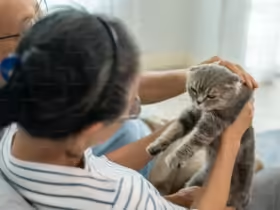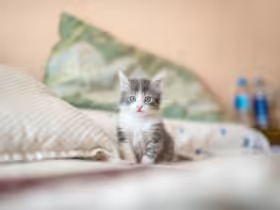Colitis in cats is an inflammatory condition of the colon that can lead to discomfort and digestive issues. Understanding the causes, recognizing the signs, and knowing how to treat colitis is essential for maintaining your cat’s health and well-being. This comprehensive guide will delve into colitis in cats, explaining what it is, how to identify it, and the best ways to manage and treat this condition.
What Is Colitis?
Colitis is the inflammation of the colon, or large intestine, which can cause a range of gastrointestinal symptoms in cats. The colon is responsible for absorbing water and electrolytes from the digested food, and inflammation can disrupt this process, leading to various issues.
Key Characteristics
- Inflammation of the Colon: Inflammation can affect the colon’s ability to function properly, leading to symptoms such as diarrhea, abdominal pain, and discomfort.
- Variable Severity: Colitis can range from mild to severe, depending on the underlying cause and the cat’s overall health.
Causes of Colitis in Cats
Several factors can contribute to the development of colitis in cats. Identifying the underlying cause is crucial for effective treatment. Common causes include:
1. Dietary Issues
- Food Allergies or Intolerances: Certain ingredients in commercial cat food can cause allergic reactions or intolerances, leading to colitis.
- Dietary Changes: Sudden changes in diet or introduction of new foods can upset the digestive system and result in colitis.
- Ingesting Foreign Objects: Cats that consume non-food items may experience gastrointestinal irritation and colitis.
2. Infections
- Bacterial Infections: Pathogenic bacteria, such as Salmonella or Campylobacter, can cause inflammation of the colon.
- Parasitic Infections: Parasites like Giardia or worms can irritate the colon and lead to colitis.
3. Inflammatory Bowel Disease (IBD)
- Chronic Inflammation: IBD is a condition characterized by chronic inflammation of the gastrointestinal tract, including the colon. It can lead to persistent colitis.
4. Stress
- Environmental Stressors: Changes in the cat’s environment, such as moving to a new home or introducing new pets, can trigger colitis due to stress.
5. Medications
- Antibiotics and Other Drugs: Certain medications, especially antibiotics, can disrupt the balance of gut flora and contribute to colitis.
6. Underlying Health Conditions
- Systemic Diseases: Conditions such as hyperthyroidism or kidney disease can impact the digestive system and cause colitis.
Signs of Colitis in Cats
Recognizing the signs of colitis early can help in managing the condition and preventing complications. Common signs include:
1. Diarrhea
Frequent, watery, or mucous-filled diarrhea is a hallmark symptom of colitis. The diarrhea may be accompanied by blood or mucus.
2. Abdominal Pain
Cats with colitis may exhibit signs of abdominal pain, such as a tense or sensitive abdomen, and may become more reclusive or irritable.
3. Vomiting
While less common, vomiting can occur alongside diarrhea, especially if the colitis is severe or if the cat has ingested something harmful.
4. Increased Frequency of Defecation
Cats with colitis may have an increased urge to defecate, leading to more frequent visits to the litter box.
5. Loss of Appetite
A decrease in appetite or refusal to eat can occur due to discomfort and gastrointestinal upset.
6. Weight Loss
Chronic colitis can lead to weight loss due to decreased food intake and malabsorption of nutrients.
7. Lethargy
General lethargy or decreased activity levels can be a result of the discomfort and pain associated with colitis.
Diagnosing Colitis in Cats
Proper diagnosis of colitis involves a combination of clinical examination, diagnostic tests, and sometimes a review of the cat’s medical history. Here’s how veterinarians typically approach diagnosis:
1. Physical Examination
The vet will perform a thorough physical examination, palpating the abdomen to check for tenderness or swelling and assessing overall health.
2. Medical History
Providing a detailed history of your cat’s symptoms, diet, and any recent changes or stressors will help the vet determine potential causes of colitis.
3. Fecal Examination
A fecal exam can identify parasites, bacterial infections, or abnormalities in the stool that may indicate colitis.
4. Blood Tests
Blood tests can help assess overall health, check for signs of infection, and evaluate organ function to rule out underlying systemic diseases.
5. Imaging
X-rays or ultrasound may be used to examine the intestines and rule out other gastrointestinal issues or obstructions.
6. Endoscopy or Biopsy
In chronic or severe cases, an endoscopic examination or biopsy may be performed to obtain samples of the colon lining for further analysis.
Treatment Options for Colitis in Cats
Treatment for colitis focuses on addressing the underlying cause, managing symptoms, and supporting overall digestive health. Here are common treatment approaches:
1. Dietary Management
- Special Diets: Switching to a hypoallergenic or easily digestible diet can help manage food allergies or intolerances. Your vet may recommend a prescription diet designed for gastrointestinal health.
- Gradual Dietary Changes: Introduce any new foods gradually to avoid upsetting the digestive system.
2. Medications
- Anti-Inflammatory Drugs: Medications such as corticosteroids may be prescribed to reduce inflammation and manage symptoms.
- Antibiotics: If a bacterial infection is identified, antibiotics may be used to treat the infection and reduce inflammation.
- Anti-Parasitic Medications: If parasites are the cause, appropriate anti-parasitic treatments will be administered.
3. Probiotics
- Gut Health: Probiotics can help restore healthy gut flora and improve digestive function, potentially reducing the frequency and severity of colitis episodes.
4. Stress Management
- Environmental Enrichment: Providing a stable, stress-free environment can help prevent stress-related colitis. This includes maintaining a consistent routine and minimizing changes in the cat’s environment.
5. Supportive Care
- Hydration: Ensure your cat stays well-hydrated, especially if diarrhea is severe. Offer fresh water at all times and consider electrolyte solutions if recommended by your vet.
- Pain Management: Address any discomfort with appropriate pain relief, as recommended by your vet.
6. Regular Monitoring
Regular follow-up visits with your vet are essential to monitor your cat’s progress, adjust treatment as needed, and prevent recurrence of colitis.
Preventing Colitis in Cats
While it may not be possible to prevent all cases of colitis, you can take steps to reduce the risk and support your cat’s digestive health:
1. Balanced Diet
Provide a balanced, high-quality diet tailored to your cat’s needs. Avoid sudden changes in diet and monitor for any signs of food allergies or intolerances.
2. Routine Veterinary Care
Schedule regular veterinary check-ups to monitor your cat’s health and address any issues before they become severe.
3. Stress Reduction
Minimize stress by maintaining a stable environment, providing enrichment, and addressing any changes or disruptions that could affect your cat’s well-being.
4. Proper Hygiene
Maintain good hygiene by regularly cleaning your cat’s litter box and providing a clean living environment to prevent infections and parasites.
5. Monitor Health
Keep an eye on your cat’s behavior, appetite, and stool quality. Early detection of any changes can help in managing potential issues before they escalate.











Leave a Reply